Filling In The Gaps Of What Should Be Common Knowledge
Scribble introduced me to the practical limitations of solenoids. Namely, they’re slow. So very, very slow. For many machines this isn’t a problem, but Scribble was forced to operate a fraction of it’s possible speed. While redesigning the pen lift goes some way to mitigate the speed penalty, it can’t speed the solenoid up. At some point the slow action of the solenoid will put a cap on the maximum speed.
I have another machine in the design phase that requires a very fast solenoid. The practicality of the machine kind of hinges entirely on how fast I can reliably toggle the solenoid. Being a sudden topic of interest, I set out to find all the information I could about speeding up solenoids.
Research proved uncommonly useless. It’s well known that adding a snubber circuit to the solenoid changes how it works- including how fast the solenoid releases. What I couldn’t really find good information on was how much gets changed. There were a few isolated experimental tests, but no practical comparison between the different types of snubber. A good snubber should dissipate the energy in the solenoid coil quickly, while being as simple as possible.
Since I can’t find the data, I guess I have to make it myself! I collected the five most common solenoid snubbers and tested them all.
Experimental Setup
Couldn’t be simpler. Take a MOSFET, a signal generator, and a power supply. Combine with solenoid. The actual circuit is tiny:

Crude, but effective. Schematics are in the next section.
Power is provided by Simple Power, gate drive by my signal generator. Any small adjustable oscillator (e.g. 555) should work, as long as it puts out a MOSFET compatible square wave up to a few tens of Hertz.
I chose the first MOSFET I could find. It turned out to be the IRLZ14, which is the MOSFET I used in Scribble. Ideal for this test, considering what prompted me to experiment.
As for testing whether the solenoid releases far enough, I simply held them in my hand. It’s very obvious when the solenoid stops extending all the way- the sound and vibration changes pretty drastically. While a proper testing jig would be more accurate, I found the noise to be incredibly loud and annoying. No way around that, I’m afraid. Even held in my hand, it still sets my ears off. At least I can feel the solenoid rattling in my hand better than I can hear it knocking against something.
Testing The Many Kinds Of Solenoid Snubber
I only have two solenoids available for this test: The TAU1040T-07 courtesy of Adafruit, and the XRN-0530 courtesy of an Amazon order that needed a little bit of extra padding to qualify for free shipping. Both have captive armatures with a built-in return spring. Neither seem to have that much information on their internals.
Unfortunately the XRN solenoid proved unsuited for severe vibrations, and the little nut holding the armature in place kept falling off. The TAU is more solidly built, so I ended up using it for all the tests. In practice I find little difference between the two.
Release speed isn’t the only reason you add snubbers to solenoids. Reducing the voltage spike at turn off is also a very important since it can blow out the driver. I’ll be taking oscilloscope screenshots of all the snubbers to compare maximum voltage.
I’ll leave you with a schematic of all the snubbers I’m going to test.

No Snubber
The simplest snubber is no snubber at all. I kind of have to do this anyways, since I need a baseline to compare the other results.
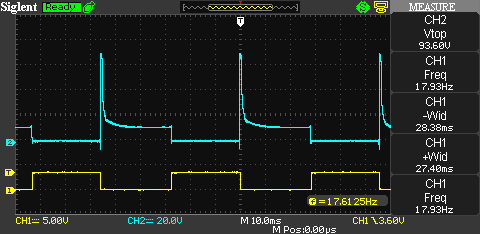
Blue is the voltage on the MOSFET drain, while yellow is the gate.
I got a maximum speed of 20Hz. This is going to be the speed value I measure all the other snubbers against.
Check that voltage spike! The IRLZ14 is only rated up to 60V. I frequently saw spikes around 70V. Occasionally up to 100V, though that seems to be a quantization error. Kind of amazing that the MOSFET doesn’t explode under all that stress!
Diode Snubber
The next simplest snubber is the classic diode snubber. A diode will clamp the coil voltage to less than 1V. I chose the 1N4004 as a generic diode. I also did some tests with the 1N4934, but it made no difference.
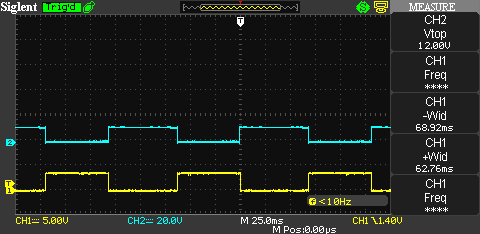
With a diode the maximum speed fell to 10Hz. This is a pretty big drop in speed! Adding the diode keeps the coil current flowing just a little bit longer- the resistance of a diode is only a few ohms. Release speed is slower as a result.
Voltage is clamped back to effectively nothing. The basic diode snubber is good at limiting the voltage spike if nothing else.
Resistor-Diode Snubber
Part of the reason the simple diode snubber performs so poorly is that the diode doesn’t dissipate the energy in the coil very fast. That’s because it’s such a low resistance component. Adding a resistor gets rid of this excess energy faster. You pay an additional cost in heat, which may or may not be acceptable.
The first test was to put 10R in series with the diode.
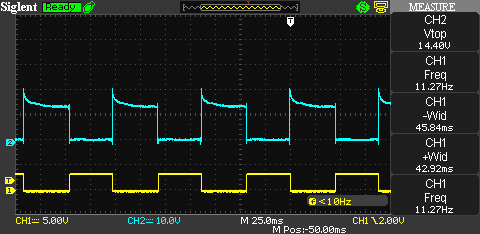
Maximum frequency went up slightly, along with the drain voltage. Unfortunately, the gain is pretty marginal. I don’t think a couple of Hertz is worth the extra effort. Voltage is clamped to a much more reasonable 15V.
What happens if we use a 100R resistor?
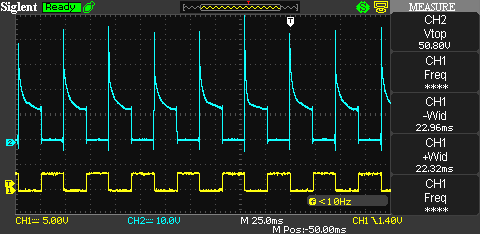
Speed goes back up to about 20Hz, but the drain voltage soars. Voltage rises dramatically, to the point where I’m worried again. Clearly for this circuit to work, you need a pretty small resistor.
Resistor-Capacitor Snubber
Instead of the diode, you often see a resistor-capacitor snubber circuit instead. RC snubbers are mandatory on AC-powered systems where a diode will simply not work. DC systems can us the RC snubber too.
My first attempt was 100n + 100R. It had no real effect whatsoever:

I tried several values of R and C, but none of them seemed to work all that well. As expected, the snubber effect is very frequency sensitive. The best I could do was 10u + 10R.
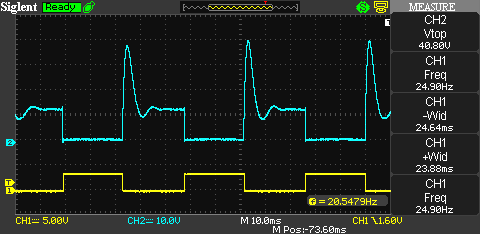
It would appear this kind of snubber is at least partially functional. Speed was not improved much, though the voltage spike was clamped. Unfortunately this only worked around 20Hz. At higher or lower frequencies the spike went back up around 60V.
Out of curiosity, I also plugged the snubber in between drain and ground, as is sometimes done. It made no difference.
Zener Snubber
Lastly, there’s the Zener snubber. I chose a 1N751A for the simple reason I have some close to hand. They will conduct around 5.1V. First I connected it across the coil with a generic diode.
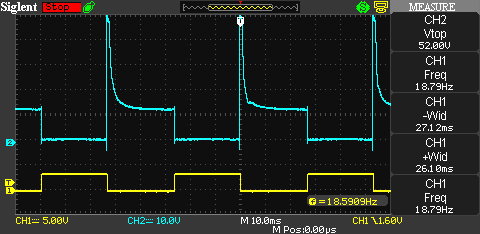
Very little effect. Disappointing, but I stuck to the experiment and tried some other Zener circuits.
Next I tried connecting the Zener-diode pair over the MOSFET.
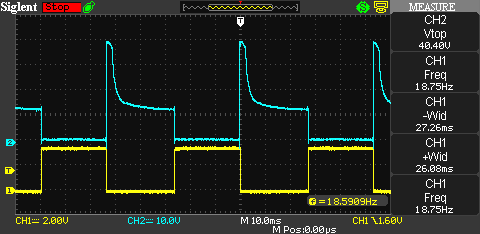
This had some effect, though it was frequency dependent like the RC snubber. I only got this result around the magic 20Hz region. Quite puzzling. I wasn’t ready to give up yet.
I went back and used an LED plus diode on the coil. This produced some results, if nothing else.
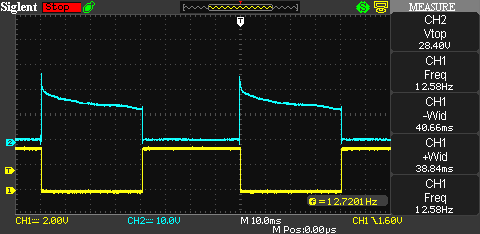
These results are more in line with the RD snubber. I don’t know why my chosen Zener diode didn’t work. Yes, I even tried another 1N751A to rule out a broken diode.
I was intrigued enough to try the Zener circuit with different 5.1V Zener (1N4733). This one produced much better results:
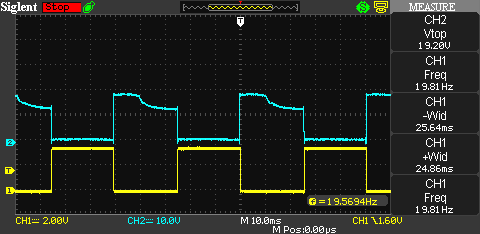
Why one diode works while the other doesn’t is kind of a mystery. Nothing in either device datasheet explains this behavior. I suspect the 1N4733 is simply slightly faster. Or, I did in fact blow out the 1N751A by over-driving it. Or something else entirely. All I know is that I don’t know why this happened.
With the 1N4733, I got up to 20Hz with a voltage spike topping out around 20V. This worked reliably over a wide range of frequencies. I think we have a clear winner!
Analysis
I’m beginning to suspect my experimental setup was flawed, or at least limited. Despite trying out a dozen or so circuits with some pretty drastic variations, I got about the same results. This leads me to believe that the primary speed limit was not the electrical characteristics of the solenoid, but the mechanical ones.
Despite losing the retaining nut multiple times, I did do a few of these experiments with the XRN. For the experiments I did, I got very similar results- just slightly faster. I put this entirely down to the XRN being physically smaller. Once again, I feel the speed limit is more mechanical in nature than electrical.
Like we’ve all been told, putting a reverse diode across the coil is very effective for clamping the reverse EMF. It does however slow the solenoid down quite a bit. Wherever super speed is not a real concern, the diode snubber is by far the cheapest, most effective snubber.
Putting a Zener in series with the diode is a very effective way of improving response time while still clamping voltage. As long as you get the right Zener for the job. It needs to carry a pretty high pulse of current during turn-off. Unfortunately, choosing the correct Zener seems to be more about trial-and-error than choosing a specific device.
Adding a small resistance in series with a plain diode improves the circuit for a small cost. But I doubt it’s better than simply using a Zener diode. You need two components either way, and the Zener is strictly superior.
RC snubbers proved completely ineffective. Maybe I’m just doing it wrong, but I got very little effect despite trying multiple values of capacitor and resistor. They were also only effective over a narrow frequency range. Unless you can tune the RC circuit to an exact set of operating conditions, I don’t see the advantage over the alternatives.
There are more exotic solenoid drivers that purport to have even better characteristics. Notably, the full bridge driver can achieve very fast release because it flips the polarity of the coil so it dumps it’s energy back into the power supply. While I’m keen to find a way to test a full bridge driver on the cheap, I feel the Zener snubber is good enough for most practical purposes.
Every once in a while, I need some knowledge that proves very difficult to find. I found all kinds of people talking about snubbers but very little in the way of quantitative comparisons. Just shallow aphorisms without much substance behind them. Engineering is more self-affirming dogma than anyone is comfortable with admitting. I’ve seen plenty of false truisms that can be refuted by simple experiments. Next time an engineer gives a lazy explanation for something, squeeze them for the reasoning and evidence.
I have a few ideas that hinge on fast acting motion. With the right knowledge, a solenoid might just make them work. I might have to delve a little deeper into magnetics to get the answers I want though. It’s a subject in dire need some some amateur experimentation.

Have a question? Comment? Insight? Post below!